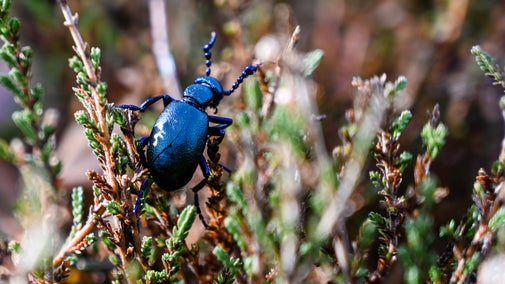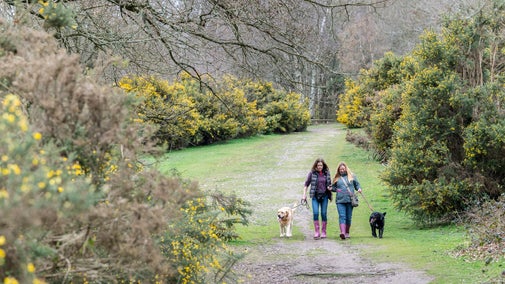
Discover more at Kinver Edge and the Rock Houses
Find out when Kinver Edge and the Rock Houses are open, how to get here, things to see and do and more.

Kinver Edge is a high heath and woodland escarpment on the Worcester/Staffordshire border. Discover the history of the quirky rock houses here, and what the remains of an Iron Age hillfort can tell us about its past.
On Kinver Edge there are several rock houses that have been carved out of the soft red sandstone. The most famous are the homes at Holy Austin Rock, now restored and open to visitors. There are stoves, furniture, windows and doors – all set into the sandstone, just as they were when the houses were lived in.
Nanny’s Rock and Vale’s Rock aren’t restored but they can be seen from the Rock Houses walking trail. You can climb into Nanny’s Rock, peer through the remains of the windows and wander around the five empty rooms. Was Nanny a herbalist, a potion maker, a white witch? Passed down through time, there is no explanation for this curious name.
The National Trust was given 198 acres of Kinver Edge in 1917 in memory of Thomas Grosvenor Lee, a Birmingham solicitor born in Kinver. Today we care for close to 600 acres of this special landscape.
The earliest record of people living here is in 1777 when Joseph Heely took refuge from a storm and was given shelter by a ‘clean and decent family’. He describes how the rock houses made good homes: ‘warm in winter, cool in summer’.
Kinver Edge provided fresh air and open space which was considered better than the village with its smoke and risk of flooding. The rock houses had water from the well and later gas, but no electricity. Sanitation was by earth closets.
Inside space was determined by how much sandstone could be dug out. Rooms could therefore be larger and ceilings higher than in the cottages and back-to-backs of towns. Rooms could be divided as families grew, and often lodgers were taken in. The 1861 census lists 11 families living here.
Some rock houses were owner-occupied, but most were rented. People worked on farms, others were self-employed or worked in local industry at the Hyde Iron Works, the Black Country or Kidderminster.
Fame of the Kinver rock houses spread far. In 1903 Alfred Rushton RA visited to paint Mr and Mrs Fletcher in their home at Holy Austin Rock, and Sir Benjamin Stone photographed scenes there at about the same time.
The site became a tourist attraction at the turn of the 20th century and the inhabitants served teas from their rock homes to visitors. A café continued here until 1967, long after the last occupants had moved out. This legacy continues today – the upper level of houses have been restored as a tea-room.
After the café closed, the Holy Austin rock houses became derelict. Several decades of vandalism, uncontrolled wilderness and weather took its toll on the fragile rock.

In 1993 the upper houses were restored as a family home once more. The restoration was accurately based on the many photographs and memories of times past.
A custodian began living here, and volunteers worked on the rest of the site, discovering and restoring the original gardens. Proper visitor access was built and suddenly, Holy Austin Rock caught public interest.
In 1996 work began at the lower level – the original home of Mr and Mrs Fletcher. The huge space known as the Ballroom was made secure with brick arches and rock bolting. Windows and doors were reconstructed exactly as the originals. Chimneys were rebuilt and fireplaces installed.
Using photographic evidence and the Rushton painting as the basis for decoration, the Fletcher cottage was depicted to represent life in the rock houses in the early 1900s. Visitors were welcomed again in October 1997.

Some hillforts were used for defence only, some as distribution and gathering places, some as defended settlements and others as powerful focal points for large areas.
Whilst most hillforts were used in the Iron Age period, it is suspected that Kinver Hillfort has origins earlier in the late Bronze Age.
The hillfort is very near the boundary between two important Iron Age tribes - a border now mirrored by the county boundary of Worcestershire and Staffordshire.
When the hillfort was first built, who lived here and what purpose it served are all questions that remain unanswered. Only archaeological investigation of the site would reveal the answers but certain clues to its past can be found by looking at what remains here and in the wider landscape.
It was an important place and a strong fortress, part of a landscape of farmland and smaller settlements. Two sides were formed by huge banks called ramparts which you can still see today, but would have been much higher than they are now. The ramparts would have probably had a wall or palisaded fence on the top. The other two sides make use of the natural promontory to provide defence – using the fantastic views which you can still enjoy today.
Inside the hillfort was probably a group of roundhouses, and when the conditions are right (usually in winter) you can make out traces of circular depressions left behind by these buildings. There is evidence for a closed-up entrance to the east side of the fort that shows it was probably repaired during its lifetime.
In more recent years the strategic location of Kinver Hillfort was exploited for Second World War defences, and you can still see a home guard shelter at the ramparts of the south west corner.

Find out when Kinver Edge and the Rock Houses are open, how to get here, things to see and do and more.
The fragile heathland habitat at Kinver Edge is home to many rare species, with more familiar plants and animals also found in the surrounding woodland.

Kinver Edge is a two pawprint rated place. It's a great place to come and exercise with your dog, with miles of footpaths and open countryside for you to explore.

The Rock House café serves everything from light bites to sandwiches and soup, all in a unique setting. Inside you’ll also find second-hand books for sale.

From looking after rare lowland heath to managing woodland for butterflies, discover some of the important work the ranger teams at Kinver Edge do.

Discover the learning opportunities at Kinver Edge and the Rock Houses, and get in touch about bringing your group.

Learn about people from the past, discover remarkable works of art and brush up on your knowledge of architecture and gardens.
